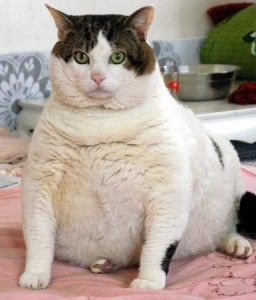Obesity is not only one of the biggest health crises facing Australians, we’ve made it a health problem for our pets too. In developed countries such as Australia, the USA and UK, on average 50% of cats are either overweight or obese.
We are here to help
Just like humans struggling with their weight, it can be a real challenge to rediscover the slim cat under all that fatty covering. At CVH we have solutions and our staff are committed to helping you set up a weight loss strategy for your pet.
How do you know if your pet is overweight?
 Pet owners are often genuinely not sure if their pet is overweight. Here are some quick tests:
Pet owners are often genuinely not sure if their pet is overweight. Here are some quick tests:
- Your cat should have a waist – stand above your pet and look for a narrowing behind the chest
- Run your fingers over the rib cage - you should be able to feel your pet’s ribs
- Learn your cat's healthy weight. Come in and weigh your pet on the electronic scales in our waiting room – our staff can give you a target weight for a comparable-sized cat.
Health issues
Overweight and obese pets suffer from many of the same health issues we do when we’re carrying too much fat:
- Diabetes (Type 2) is a growing problem in both cats and dogs, often initiated by obesity.
- Obese cats can develop a potentially fatal condition, fatty liver syndrome.
- Extra weight puts serious pressure on joints and makes it harder for pets to be active and exercise. All ageing pets with arthritis respond remarkably well to weight loss, and become more active and interested in exercise when they lose weight.
- Overweight pets often develop deep skin folds, setting up the perfect moist environment for inflammation and infection.
- Excess weight also prevents cats from grooming themselves properly on the back and around their tail, leading to matted, dirty fur.
- Dogs fed fatty meals are vulnerable to life-threatening pancreatitis.
- Many human treats are dangerous for pets – even a small amount of chocolate can be fatal for dogs in particular.
How to tackle obesity
The first big step is to acknowledge your precious puss is overweight. The second is to acknowledge that you – not your pet – control the food dish. The third step is developing a diet and exercise plan for your pet that suits your lifestyle.
Let our vets help you set a healthy target weight. Come in every 2 weeks to weigh your cat – there is no charge for using the electronic scales in our waiting room (we use them too!) and we encourage all our clients to drop in without a consultation and weigh their pets regularly.
Talk to us about dietary alternatives. If you feel you are unable to change the way you feed your pet without help, we stock high quality, tasty weight loss biscuits and canned food. These are properly balanced with all the vitamins and minerals your cat needs and are designed to make your pet feel full and satisfied, but with far less calories. Prescription diets such as Hills R/D provide 40 percent of the calories of regular food – they really do work.
Become disciplined. Never leave food out between meals and don’t use your cat as a compost bin, cleaning up the leftovers. Your toughest challenge will be learning to ignore the pleading eyes and manipulating behaviour, but we can guarantee you will be rewarded with a happier, more active and healthier pet.
It’s also important to know that cats and dogs in the wild often went days without food and survived perfectly well. Domestication has imposed a regular diet on our pets, but as long as they have a constant supply of water, eating less will not cause harm.